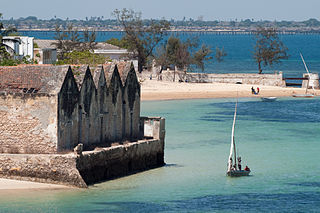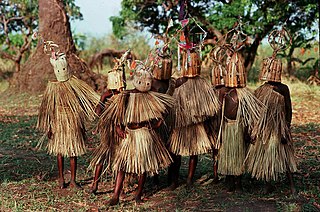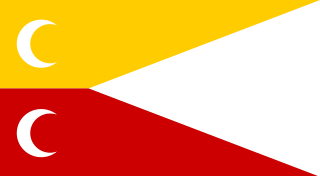
The Makua people, also known as Makhuwa or Wamakua, are a Bantu ethnic group found in northern Mozambique and the southern border provinces of Tanzania such as the Mtwara Region. They are the largest ethnic group in Mozambique, and primarily concentrated in a large region to the north of the Zambezi River.

Angoche Island is a small island in the district of same name in Mozambique. The island lies at the mouth of the Mluli River; the river enters the sea at the southernmost point of a large bay which contains a number of low, marshy islands. One of these islands was home to the ancient Islamic settlement of Angoche, and the island is thus known as Angoche Island. A coastal island, its main source of income was the illegal shipment of enslaved people, which enriched the aristocratic classes of the Nyapakho clan. It was not taken by the Portuguese until 1913, thanks to the brave resistance of the sultan, particularly Ibrahim Iussuf. His nephew, who was the commander-in-chief of a 30,000 men army took over power and opposed with tenacity the Portuguese until 1890. By then, Farlah, the last sultan, resumed the war against the Portuguese until he was captured in a battle in 1910 and deported to East Timor where he died in prison. The small island is subject to cyclones; Cyclone Huda in particular is remembered, and so permanent habitation has not been possible. Angoche is the largest producer of cashew and shrimps in Mozambique.

Angoche is a district, city and municipality located in Nampula Province in north-eastern Mozambique. The district has limits in the North with Mogincual District, in the South with Larde District, to the east with the Indian Ocean and to the west with Mogovolas District. The principal town is Angoche. It is located 185 km from the provincial capital, Nampula City.
The Swahili people comprise mainly Bantu, Afro-Arab, and Comorian ethnic groups inhabiting the Swahili coast, an area encompassing the East African coast across southern Somalia, Kenya, Tanzania, and northern Mozambique, and various archipelagos off the coast, such as Zanzibar, Lamu, and the Comoro Islands.

The Island of Mozambique lies off northern Mozambique, between the Mozambique Channel and Mossuril Bay, and is part of Nampula Province. Prior to 1898, it was the capital of colonial Portuguese East Africa.

The Yao people are a major Bantu ethnic and linguistic group living at the southern end of Lake Malawi. They played an important role in the history of Southeast Africa, notably in the 19th century. The Yao are a predominantly Muslim-faith group of about two million, whose homelands encompass the countries of Malawi, the north of Mozambique, and the Ruvuma and Mtwara Regions of Tanzania. The Yao have a strong cultural identity, transcending national borders.

Sofala, at present known as Nova Sofala, used to be the chief seaport of the Mwenemutapa Kingdom, whose capital was at Mount Fura. It is located on the Sofala Bank in Sofala Province of Mozambique. The first recorded use of this port town was by Mogadishan merchants. One possible etymology for Sofala is "go and cultivate" in the Somali language, showing the city as a hub for gold.
The Koti language, or Ekoti, is a Bantu language spoken in Mozambique by about 100,000 people. Koti is spoken in the area surrounding Koti Island and is the major language of Angoche, the capital of the district with the same name in the province of Nampula.

The Rahanweyn, also known as the Digil and Mirifle is a major Somali clan. It is one of the major Somali clans in the Horn of Africa, with a large territory in the densely populated fertile valleys of the Jubba and Shebelle rivers and the areas inbetween, which are mainly inhabited by settlers from the Digil and Mirifle lineages.

The Angoche Sultanate was an important sultanate centered on the islands of Angoche, present-day Northern Mozambique coastline. Established in the late 15th century by dissidents from the Kilwa Sultanate, the sultanate arose during the decline of the Kilwa and Sofala, serving as an alternative entrepôt outside of Portuguese control to the inland trade fairs in the Zambezi and Mashonaland. The trade was mainly in ivory, ambergris, gold, and slaves, though the local craftsmen were known throughout the east for the straw mats and straw hats which they made.

Mikindani is a historic coastal town located in Mtwara-Mikindani District of Mtwara Region in Tanzania. The name comes from the Swahili word mikinda which means "young coconut trees". Therefore, the term "Mikindani', literally means "the place where there are young coconut trees" in old Swahili language. Mikindani is part of the city of Mtwara and is governed by the Mtwara Mikindani Municipal Council. The site is a registered National Historic Site.

Mozambique is a Christian majority country, with Islam being a minority faith practiced by around 17.5% of the population as of 2020. The faith was introduced by merchants visiting the Swahili coast, as the region was part of the trade network that spanned the Indian Ocean. This later led to the formation of several officially Muslim political entities in the region.

The Sultanate of Zanzibar, also known as the Zanzibar Sultanate, was an East African Muslim state controlled by the Sultan of Zanzibar, in place between 1856 and 1964. The Sultanate's territories varied over time, and after a period of decline, the state had sovereignty over only the Zanzibar Archipelago and a 16-kilometre-wide (10 mi) strip along the Kenyan coast, with the interior of Kenya constituting the British Kenya Colony and the coastal strip administered as a de facto part of that colony.

The Kilwa Sultanate was a sultanate, centered at Kilwa, whose authority, at its height, stretched over the entire length of the Swahili Coast. According to the legend, it was founded in the 10th century by Ali ibn al-Hassan Shirazi, a Persian prince of Shiraz.

Angoche District is a district of Nampula Province in north-eastern Mozambique, with limits in the north with Mogincual District, in the south with Larde District, to the east with the Indian Ocean and to the west with Mogovolas District. The principal town is Angoche. It is located 185 km from the provincial capital, Nampula City.

The Swahili coast is a coastal area of Southeast Africa, bordered by the Indian Ocean and inhabited by the Swahili people. It includes Sofala ; Mombasa, Gede, Pate Island, Lamu, and Malindi ; and Dar es Salaam and Kilwa. In addition, several coastal islands are included in the Swahili coast, such as Zanzibar and Comoros.
The Shirazi people, also known as Mbwera, are a Bantu ethnic group inhabiting the Swahili coast and the nearby Indian ocean islands. They are particularly concentrated on the islands of Zanzibar, Pemba and Comoros.

The Isaaq Sultanate was a Muslim sultanate that ruled parts of the Horn of Africa in the 18th and 19th centuries. The kingdom spanned the territories of the Isaaq clan in modern-day Somaliland and Ethiopia. It was governed by the Rer Guled Eidagale branch of the Garhajis clan and is the pre-colonial predecessor to the Republic of Somaliland.
The Sa'ad Musa or Saad Musa is a northern Somali clan. Its members form a part of the Subeer Awal sub-clan of the Isaaq clan family. The Sa'ad Musa traditionally consists of nomadic pastoralists, coastal people, merchants and farmers. The clan inhabits Somaliland, including Maroodi Jeex, Awdal and Sahil as well as Djibouti, the Somali Region of Ethiopia, Kenya and Tanzania.

The Portugal–Angoche conflict refers to a series of wars between the Angoche Sultanate and the Portuguese Empire between 1847 and 1910.















